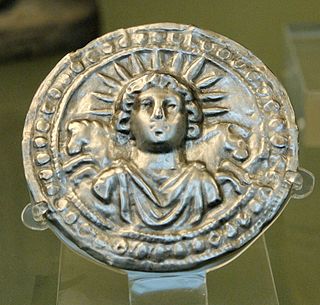
The 120s was a decade that ran from January 1, AD 120, to December 31, AD 129.

Year 321 (CCCXXI) was a common year starting on Sunday of the Julian calendar. In the Roman Empire, it was known as the Year of the Consulship of Crispus and Constantinus. The denomination 321 for this year has been used since the early medieval period, when the Anno Domini calendar era became the prevalent method in Europe for naming years.
The 140s decade ran from January 1, 140, to December 31, 149.
Year 121 (CXXI) was a common year starting on Tuesday of the Julian calendar. At the time, it was known as the Year of the Consulship of Verus and Augur. The denomination 121 for this year has been used since the early medieval period, when the Anno Domini calendar era became the prevalent method in Europe for naming years.
Year 165 (CLXV) was a common year starting on Monday of the Julian calendar. At the time, it was known as the Year of the Consulship of Orfitus and Pudens. The denomination 165 for this year has been used since the early medieval period, when the Anno Domini calendar era became the prevalent method in Europe for naming years.
Year 195 (CXCV) was a common year starting on Wednesday of the Julian calendar. At the time, it was known in Rome as the Year of the Consulship of Scrapula and Clemens. The denomination 195 for this year has been used since the early medieval period, when the Anno Domini calendar era became the prevalent method in Europe for naming years.

Year 302 (CCCII) was a common year starting on Thursday of the Julian calendar. At the time, it was known as the Year of the Consulship of Constantius and Valerius or, less frequently, year 1055 Ab urbe condita. The denomination 302 for this year has been used since the early medieval period, when the Anno Domini calendar era became the prevalent method in Europe for naming years.
Year 283 (CCLXXXIII) was a common year starting on Monday of the Julian calendar. At the time, it was known as the Year of the Consulship of Carus and Carinus. The denomination 283 for this year has been used since the early medieval period, when the Anno Domini calendar era became the prevalent method in Europe for naming years.
Year 256 (CCLVI) was a leap year starting on Tuesday of the Julian calendar. At the time, it was known as the Year of the Consulship of Claudius and Glabrio. The denomination 256 for this year has been used since the early medieval period, when the Anno Domini calendar era became the prevalent method in Europe for naming years.

Year 266 (CCLXVI) was a common year starting on Monday of the Julian calendar. At the time, it was known as the Year of the Consulship of Gallienus and Sabinillus. The denomination 266 for this year has been used since the early medieval period, when the Anno Domini calendar era became the prevalent method in Europe for naming years.
Year 190 (CXC) was a common year starting on Thursday of the Julian calendar. At the time, it was known as the Year of the Consulship of Aurelius and Sura. The denomination 190 for this year has been used since the early medieval period, when the Anno Domini calendar era became the prevalent method in Europe for naming years.

Year 193 (CXCIII) was a common year starting on Monday of the Julian calendar. At the time, it was known as the Year of the Consulship of Sosius and Ericius. The denomination 193 for this year has been used since the early medieval period, when the Anno Domini calendar era became the prevalent method in Europe for naming years.
Year 194 (CXCIV) was a common year starting on Tuesday of the Julian calendar. At the time, it was known as the Year of the Consulship of Septimius and Septimius. The denomination 194 for this year has been used since the early medieval period, when the Anno Domini calendar era became the prevalent method in Europe for naming years.

Year 180 (CLXXX) was a leap year starting on Friday of the Julian calendar. At the time, it was known as the Year of the Consulship of Rusticus and Condianus. The denomination 180 for this year has been used since the early medieval period, when the Anno Domini calendar era became the prevalent method in Europe for naming years.

Year 208 (CCVIII) was a leap year starting on Friday of the Julian calendar. At the time, it was known as the Year of the Consulship of Aurelius and Geta. The denomination 208 for this year has been used since the early medieval period, when the Anno Domini calendar era became the prevalent method in Europe for naming years.
Year 212 (CCXII) was a leap year starting on Wednesday of the Julian calendar. At the time, it was known as the Year of the Consulship of Asper and Camilius. The denomination 212 for this year has been used since the early medieval period, when the Anno Domini calendar era became the prevalent method in Europe for naming years.
Year 9 BC was either a common year starting on Wednesday, Thursday or Friday or a leap year starting on Thursday of the Julian calendar and a leap year starting on Monday of the Proleptic Julian calendar. At the time, it was known as the Year of the Consulship of Drusus and Crispinus. The denomination 9 BC for this year has been used since the early medieval period, when the Anno Domini calendar era became the prevalent method in Europe for naming years.
Year 125 BC was a year of the pre-Julian Roman calendar. At the time it was known as the Year of the Consulship of Hypsaeus and Flaccus and the Fourth Year of Yuanshuo. The denomination 125 BC for this year has been used since the early medieval period, when the Anno Domini calendar era became the prevalent method in Europe for naming years.
Year 142 BC was a year of the pre-Julian Roman calendar. At the time it was known as the Year of the Consulship of Calvus and Servilianus. The denomination 142 BC for this year has been used since the early medieval period, when the Anno Domini calendar era became the prevalent method in Europe for naming years.
A calendar era is the period of time elapsed since one epoch of a calendar and, if it exists, before the next one. For example, the current year is numbered 2025 in the Gregorian calendar, which numbers its years in the Western Christian era.






